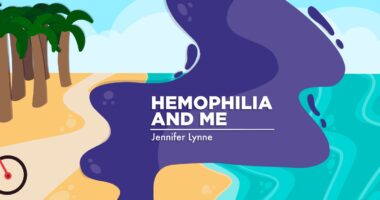Hemophilia May Be a Man’s World, but It’s Full of Superheroes

As a woman living with hemophilia, I’ve always understood that hemophilia is a man’s world. But I’ve also discovered that the men inhabiting this world are kind, compassionate superheroes with massive struggles of their own.
My first National Hemophilia Foundation conference was in 2018 in Orlando, Florida. More than 2,800 people gathered for the four-day event.
A conference highlight was the premiere of a documentary featuring Chris Bombardier, who lives with severe hemophilia B. His heroic quest to climb the world’s highest mountains is the subject of the documentary “Bombardier Blood.” The documentary and Chris received a well-deserved standing ovation.

The premiere of “Bombardier Blood” at the National Hemophilia Foundation conference in Orlando in 2018. (Photo by Jennifer Lynne)
The all-but-forgotten generation
I was looking forward to a session on aging with hemophilia. I bolted into the small Marriott conference room a few minutes late. The facilitators had arranged the room with the chairs in a circle. To me, this signaled an open discussion would take place. I felt all eyes move toward me, the only female in the room aside from the presenter.
Awkward. I pivoted to leave but remembered I had a vested interest in the topic. After all, I am aging with hemophilia. Feeling like I didn’t belong, I braced myself and took a seat in the circle.
Members of the first generation of men living into their 60s, 70s, and 80s with hemophilia were seated in the circle. Survivors who didn’t expect to grow old. Members of an all-but-forgotten generation of over 10,000 people with hemophilia who contracted HIV/AIDS from the clotting factors they needed to stop their bleeding.
In 1960, the life expectancy of someone born with severe hemophilia was less than 20 years. In the late ’60s, the development of freeze-dried concentrates of the clotting factors from blood improved lives. But in the ’70s and ’80s, the clotting factor medicine became tainted with HIV/AIDS and hepatitis.
The National Hemophilia Foundation notes that, “From the late 1970s to the mid-1980s, about half of all people with hemophilia became infected with HIV after using contaminated blood products. An estimated 90% of those with severe hemophilia were infected with HIV. Many developed AIDS and thousands died.”
With improved treatment, the life expectancy of people born today with severe hemophilia has dramatically improved to about 10 years less than healthy men.
The D-word
When the session pivoted to an open discussion, someone mentioned the D-word. Tears flowed. Many of the men were suffering from significant depression. Soon tears were running uncontrollably down my cheeks, too.
As if hemophilia wasn’t enough of a burden, several men lived with AIDS and hepatitis. They struggled with unemployment, high healthcare costs, and relationship challenges. Many had survivor’s guilt, as they had lost close friends to AIDS.
When it was my turn, I struggled to tell my story of living through the ’80s with hemophilia and von Willebrand disease. My voice cracked, and I choked out just a few sentences. I had never talked about it before.
I had so much in common with these men. Words cannot describe the terror of living through the ’80s with a bleeding disorder. Regular reminders from my hemophilia treatment center warned that I might be infected with HIV or hepatitis. I still receive screening for HIV/AIDS because of the treatment I received in the ’80s.
I am grateful to these men for accepting me into their session. This discussion forever changed my life. (The documentary “Let’s Talk,” which focuses on mental health in the bleeding disorder community, refers to what happened in the room that day.)
Today’s generation
Two years later, I attended a Zoom conference for women affected by hemophilia B. Most women participating had sons with hemophilia. Several mothers were struggling to infuse their ultra-cute squirmy toddlers with factor.
Afterward, I thought back to the session I had attended in 2018. These mothers were too young to know the heartbreak of the mothers who lost their hemophiliac children to AIDS decades earlier. May they never experience that pain.
These little boys will have a hemophilia experience entirely different than the men I met in Orlando. Clotting factors tainted with HIV/AIDS and hepatitis are distant memories. Longer-lasting medicine will mean fewer pokes, and gene therapy is around the corner.
Where does a woman with hemophilia fit into this world? I’m not sure. But my story and the story of these superhero men are essential for us to understand the past. We need to be sure this medical tragedy does not repeat itself.
And may we never forget those young superheroes we lost along the way.
***
Note: Hemophilia News Today is strictly a news and information website about the disease. It does not provide medical advice, diagnosis, or treatment. This content is not intended to be a substitute for professional medical advice, diagnosis, or treatment. Always seek the advice of your physician or another qualified health provider with any questions you may have regarding a medical condition. Never disregard professional medical advice or delay in seeking it because of something you have read on this website. The opinions expressed in this column are not those of Hemophilia News Today or its parent company, Bionews, and are intended to spark discussion about issues pertaining to hemophilia.








Leave a comment
Fill in the required fields to post. Your email address will not be published.